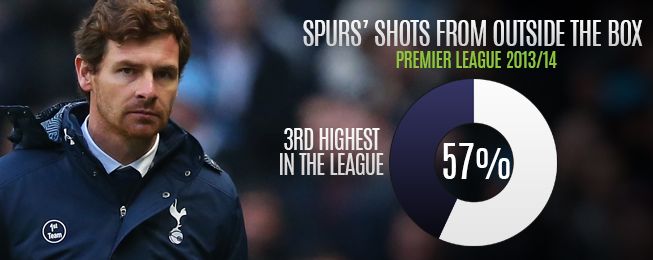
Team Focus: The problem with Tottenham Hotspur's attack

There is no side in the Premier League whose attack has so failed to live up to expectations this season as Tottenham’s. Only Crystal Palace and Sunderland have scored fewer than Spurs’ nine goals in 12 games so far, and that figure becomes even more worrying when it’s considered that two of the goals they did score came from debatable penalties.
Sunday’s 6-0 defeat to Manchester City was, as Andre Villas-Boas noted, embarrassing, but the danger is that the way the midfield capitulated obscures other issues. There obviously must be concerns about the widespread abnegation of responsibility in the second half, the shapelessness and the lack of fight, but it remains possible that was just a one-off. For the first 11 games of this season, the defence was laudable.
It sounded odd when Villas-Boas began talking about Tottenham’s failure to create chances, but up to a point he was right: until the second goal went in Tottenham were matching City and they won the battle for possession 53%-47%. “We never had a proper chance to score,” he said. “We have to look into it more in depth, not that we haven’t looked already. Sometimes it is because of the opponents, sometimes we don’t do enough.” Yet there is a paradox here. For while Spurs didn’t look like scoring and while their goals record is clearly desperately poor, they have averaged 18.3 shots per game, more than any other side in the league. That is an astonishing disparity.
Charles Reep, the much-maligned long-ball theorist who pioneered the statistical analysis of football in Britain, claimed that over time, pretty much all teams score with one shot out of every nine – in which case Spurs should be averaging two goals per game. Reep was dogmatic and occasionally blinkered in his reading of data, but there is no reason to doubt his figures themselves.

Reep was a major influence on the former Norway coach Egil Olsen. He is rather subtler in his thinking than Reep, but he too believes shots are a ready measure of domination, finding that over three-quarters of all games are won by the side that has more shots. Reep argued teams should effectively shoot on sight, reasoning that an increase in shots per game will lead to an increase in goals; Olsen acknowledges that there are different levels of chance. He began subdividing chances into three categories – easy, medium and hard – but discovered that for his Norway, the additional sophistication of method yielded nothing meaningful in terms of results.
Last week I asked him about Tottenham’s problems and, although he admitted barely having watched them this season, he immediately offered as a diagnosis that they were trying too much that is too speculative. The easy/medium/hard metric is clearly subjective, but what we can say is that Spurs have had only 4% of their shots from inside the 6-yard box, the fourth lowest proportion in the Premier League, and 57% from outside the 18-yard box, the third highest.
That suggests too many shots taken too soon, wild punts from range rather than the sort of patient build-up that might yield better chances. It’s not difficult to isolate the main culprits: Andros Townsend, who has unleashed 4.5 shots per game but scored only one goal in 45 attempts, and Paulinho, who unleashes 3.2 per game and has scored one in 38 attempts. No other player in the league who has scored as few goals has taken more than 30 shots.
Townsend, in fairness to him, does make 1.9 key passes per game, joint 14th in the overall Premier League list, although he is yet to register an assist this season, which suggests the problem may lie in the finishing of others as well as in his own love of a shot, but Paulinho is down in 62nd.
Perhaps Spurs are, to use Reep’s term, “owed” a few goals; perhaps a few long-range efforts will suddenly fly in, but it’s hard not to conclude that their general approach wouldn’t benefit from a little more patience.